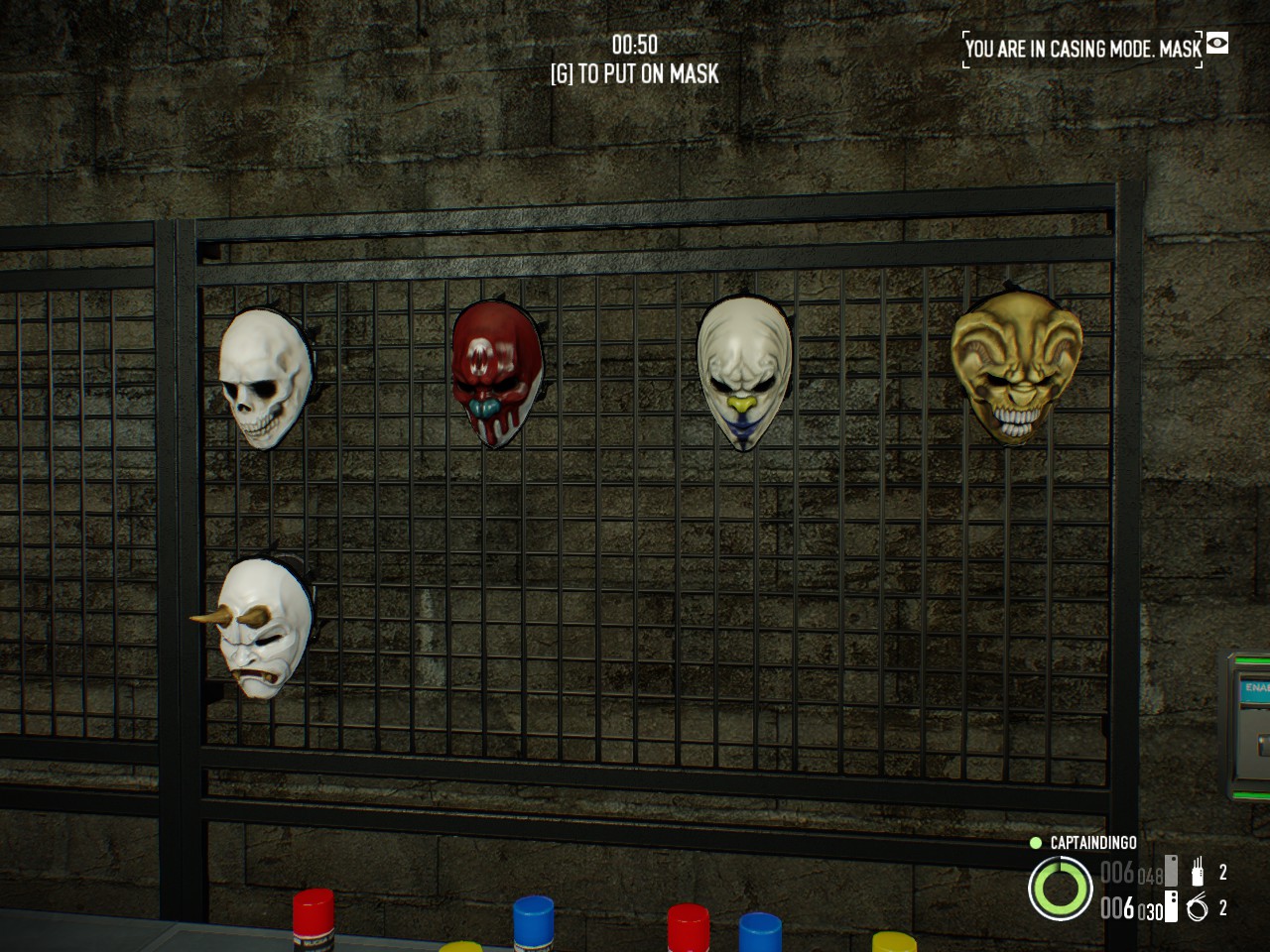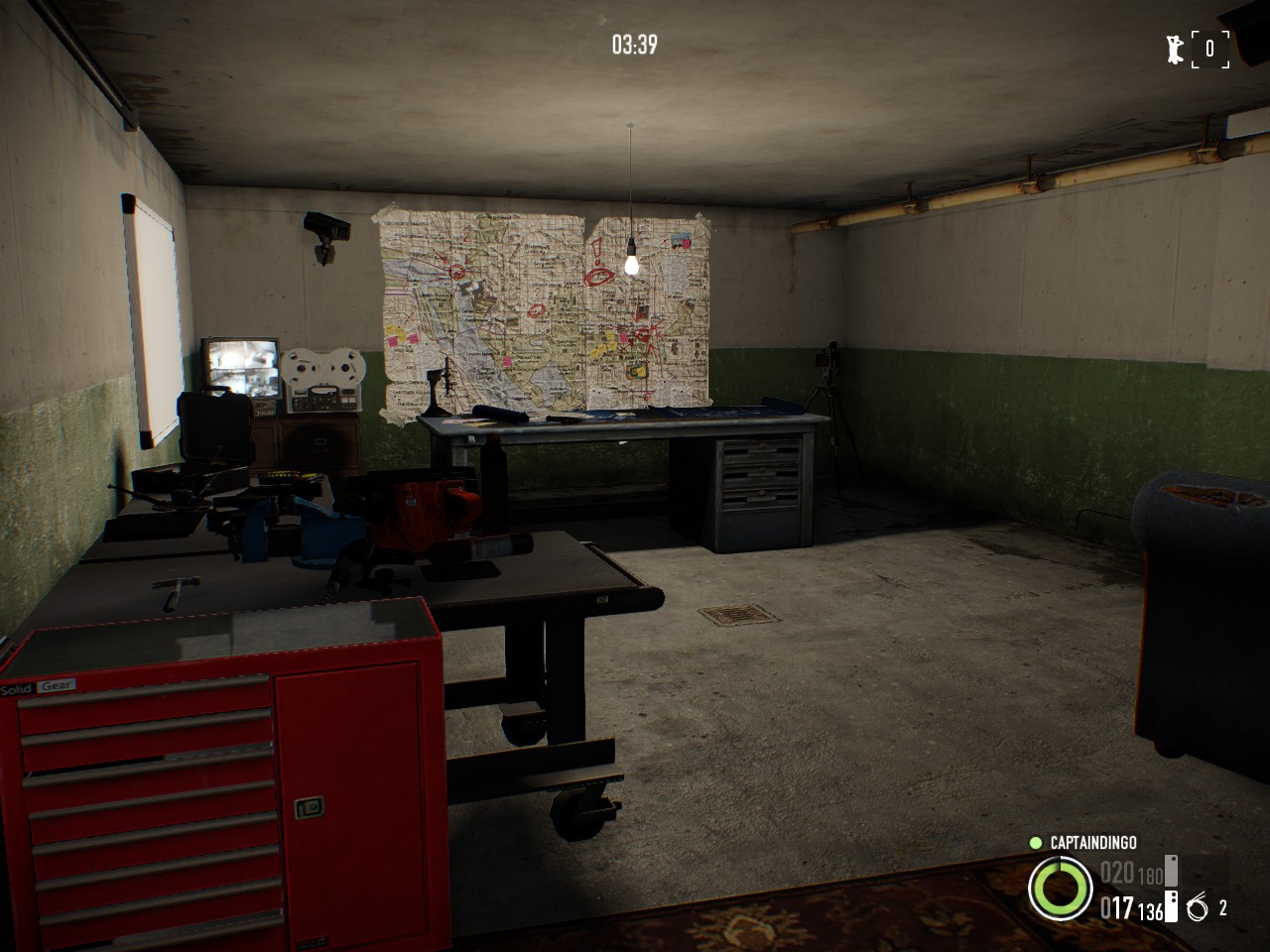PayDay: The Heist showed us how much fun we could have stealing money with friends, and while it was a really cool experience it left a lot to be desired. The heists, while filled with some randomly-generated details, had ultimately only one way to complete them with very strict parameters. Heck, I outlined PayDay’s shortcomings in the review I did of it previously which you can find here.
Unless you’re a mutant of some sort, you probably won’t be able to count all of PayDay 2’s improvements on one hand.
Let’s not rush things, though. As was the case in the first game, you can select one of four thieves: Dallas, Chains, Hoxton, or Wolf, each better known for their signature masks used to disguise their dirty deeds. If you’ve played PayDay, you already know how the game works in a general sense. You coordinate in a cooperative way with up to 3 friends and try to bag as much money as possible before you break away and make your dashing escape.
To do this, you’ll use the new level select screen known as Crime.net. The Crime.net screen can be accessed online or offline; if you choose online, you’ll probably be instantly bombarded with dozens of tags on the map, each one a heist that someone in the world is currently taking part in. There will also be “empty” levels, which allow you to start your own game. In this sense, Crime.net works simultaneously as a game browser and level select. Should you decide to play offline, or filter Crime.net Online to be friends-only, you’ll only see empty levels allowing you to create your own game. If a friend is playing, their tag will appear in a distinct color from strangers’ games. Heists can be one-day affairs or multi-day heists of epic proportions, rewarding equally epic cash; there are a whole bunch of them, too.
The Crime.net system is interesting, but it does have some downfalls. If you have a very specific idea of what level you want to play, say Four Stores on Very Hard difficulty, you’ll have to wait for it to pop up on the map. So meanwhile you might see a Four Stores Easy pop up, a Four Stores Overkill, etc. and for pure level selection, the system can feel like a waste of time. You might even feel like it would just be better to have a “normal” level/difficulty selection menu. Levels come in all varieties of payouts and difficulties, which multiply your rewards. But anyways, all that said, it’s not hard to get into the level you want, and once you do, you’re greeted to many core changes to the game.
Casing mode, the part before you put your mask on, now has a very distinct purpose. Depending on how you’re equipped, civilians and guards can take notice of you, especially if you walk into restricted areas. It allows everyone to take a good position before it all goes down. But maybe it doesn’t all have to go down at once…
One of the largest changes is the fact that each player can put their masks on individually, leaving the other players in casing mode to keep tabs on the surroundings in relative safety while masked players perform illegal actions. Indeed, it’s possible (with a lot of coordination) to stealth several of the levels in PayDay 2. Alarms aren’t magical or scripted as they were in PayDay. Taking illegal actions (or just crawling around on the floor wearing a clown mask like a creep) will cause an alert meter to fill for anyone who sees you. This bar fills much faster with guards than it does civilians, and when it’s maxed out, civilians will panic/run/call the police and guards will try to arrest or kill you. If you don’t diffuse these situations, the panic can spread quickly and you’ll undoubtedly spring an alarm, initiating the endless assault waves PayDay is known for.
In these assault waves you’ll see many old foes (with a new coat of paint, of course). Tasers, Bulldozers, Cloakers, and Shields will pepper the assaults and prove a massive thorn in your side along with the disposable grunt police… some less disposable than others, donning new and improved ballistic protection.
The win conditions in PayDay 2 are also a bit more blurry, which is a good thing. Most missions only require you to recover a minimum number of money bags, or grab a minimum amount of cash/valuables. You can choose whether you tough out the assault waves and grab as much as possible or leave with what you’ve got. This new freedom in how you approach and complete heists is a welcome overhaul.

If there weren’t enough masks for you in PayDay: The Heist, you’ll find all this and many more in PayDay 2.
At the end of each heist, every participating player picks one of three cards. The cards are a surprisingly major part of the game, as they’re the only way to unlock masks, mask components, and weapon parts.
As if this review wasn’t dripping with enough positivity, character progression is now greater than before. When you level up, you receive points that you can spend (along with a mandatory cash fee) to choose passive upgrades in one of 4 trees: Mastermind who specializes in being a control freak, Enforcer who specializes in being an unstoppable beef train, Technician who specializes in explosives, drills, and turrets, and the Ghost, a tree focusing on intense maneuverability, efficiency, and stealth. You can either go all in to one tree or get a hybrid build going, very far removed from the upgrade system in PayDay where you don’t ultimately make very many choices.
You can also buy, upgrade, equip, customize, and fiddle with weapons and masks. Want a shotgun with a silencer? Do it. Want to scare the living shit out of the police with thunderous gunfire? Throw a suppressive barrel on your Bronco.
If you’ve played PayDay, you know what to expect visually and aurally. PayDay 2 does generally look slicker, and animations are noticeably improved. The music is very reminiscent of the first game in a good way, and it does a good job of making you feel tense as it builds to an assault wave being unleashed.
It’s not all roses, though. There’s a bit of inconsistency in how security cameras work. While in the Bank level security cameras are realistic and can be “disabled” by knocking out the guard in the security room, in other levels like Four Stores the cameras are apparently being monitored by wizardry and can only be disabled “manually” by breaking them individually. Civilians sometimes appear to have superhuman senses and can see crimes going on across the street through dingy windows in a dark room, spreading panic and causing a feeling of unfairness. You also still can’t move hostages, which makes controlling them needlessly difficult. PayDay 2’s bot AI is dumb as a brick as they were in PayDay; they won’t pick up loot, tie hostages, use deployables, and can’t even be made to wear body armor. You’ll definitely want to bring at least one friend along, since playing alone isn’t viable at all and any mission that has you bringing multiple bags to a van will mean multiple trips if you lack human players.
The above problems can be irritating, but don’t ruin the overall experience and are presumably fixable. On the whole, PayDay 2 is a fantastically good romp that should keep hardcore players going for dozens, if not hundreds of hours. Good job again, Overkill. You guys are alright.









